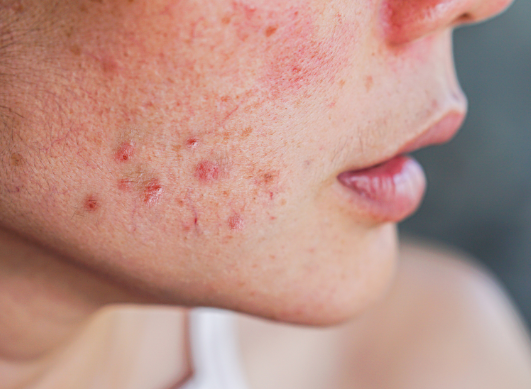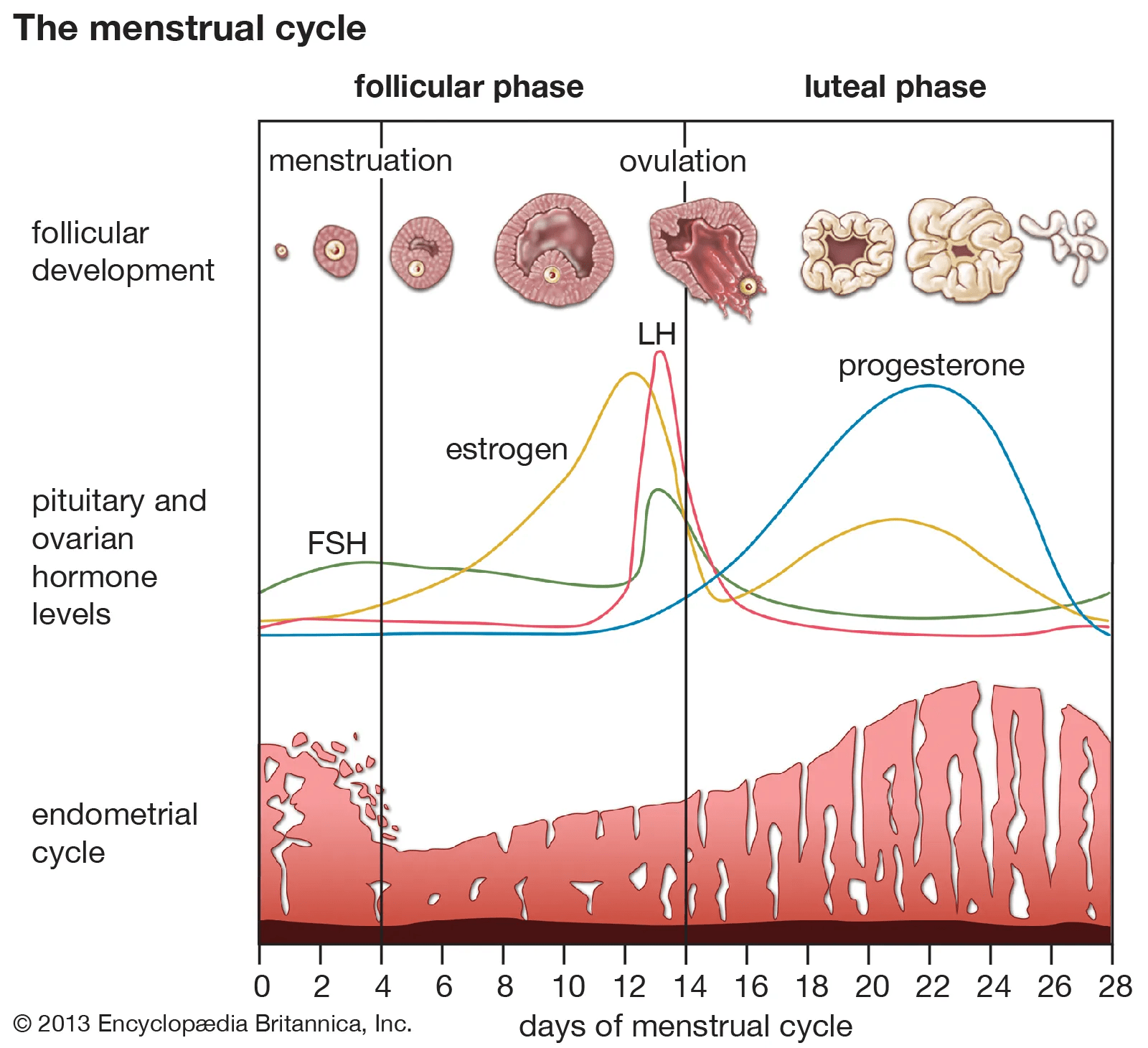How Do Hormones Affect Your Skin During the Menstrual Cycle?
Published 12 Nov 2023 • By Somya Pokharna
For many individuals, skin problems like acne can often lead to persistent feelings of embarrassment, self-consciousness, and low self-esteem, profoundly impacting their self-confidence and emotional well-being. Among women of reproductive age, in particular, these issues can be magnified due to hormonal imbalances that frequently accompany the menstrual cycle.
This begs the following questions: How do hormones affect the skin during the menstrual cycle? What can be done to manage hormonal skin changes?
Dig into this article to find out more!

What are hormones?
Hormones are chemicals produced by various glands in the body such as the thyroid, adrenal, and pituitary glands that form the endocrine system. These molecules are released into the bloodstream to travel and transmit messages to various body organs, skin, muscles, and tissues, guiding their actions and timing.
Hormones play an important role in maintaining the body's internal balance, known as homeostasis, by influencing and regulating functions such as blood pressure, blood sugar, fluid and electrolyte levels, and body temperature. They also play a pivotal role in regulating physiological processes like growth, metabolism, sexual function, reproduction, the sleep-wake cycle, mood, stress response and more.
Hormones are essential for the proper functioning of the body and help coordinate various activities to ensure overall health and well-being.
How do hormones affect the skin?
Hormones have a significant impact on the condition and appearance of our skin.
Estrogen stimulates collagen, elastin, and hyaluronic acid production to help maintain the skin's plumpness and firmness. As we age and estrogen levels decrease, our skin tends to become thinner, drier, and less elastic.
Progesterone, on the other hand, increases sebum production in the skin, which can lead to acne and oily skin. It stimulates the sebaceous glands, causing the skin to swell and the pores to appear compressed. Excessive progesterone can result in oil buildup.
Testosterone, primarily produced in men but present in small amounts in women, can also stimulate sebum production, leading to acne and oily skin.
Luteinizing hormone (LH), along with follicle-stimulating hormone (FSH), is essential for the female reproductive system as it stimulates the production of eggs in the ovaries and their release. FSH and LH also prompt the ovaries to produce estrogen.
Cortisol, a hormone produced by the adrenal glands in response to stress, can lead to skin inflammation when its levels are elevated. This inflammation can exacerbate various skin conditions, including acne and eczema.
Thyroid hormones play a role in regulating skin moisture levels and hair growth. Hypothyroidism, characterized by low thyroid hormone levels, may result in dry, thinning skin and hair loss. On the other hand, hyperthyroidism, associated with high thyroid hormone levels, can lead to oily skin and hair.
Growth hormone is essential for collagen production and maintaining skin thickness. However, as we age and our growth hormone levels decline, our skin can become thinner and less elastic, contributing to the signs of aging.
How does the skin change during the menstrual cycle?
The menstrual cycle is typically divided into several phases:

Follicular Phase
Day 1-6 (Menstruation)
This is the beginning of the cycle and starts with the shedding of the uterine lining. It is marked by the release of blood and tissue from the uterus, commonly referred to as a woman's period. During this phase, all hormones—estrogen, progesterone, and testosterone—are at their lowest levels. Sebum production decreases, which can lead to dull, dry, and sensitive skin.
To address this issue, it is recommended to use hydrating products, such as moisturizers or serums containing hyaluronic acid, to keep the skin looking plump.
The follicular phase overlaps with menstruation and involves the development of follicles in the ovaries. One of these follicles will eventually mature into an egg (ovum).
Day 7-11
During the latter half of the follicular phase, when the period stops, estrogen production resumes and this surge promotes healthy cell turnover and a more even skin tone. Skin becomes firmer and more radiant as estrogen stimulates collagen production, leading to hydrated, clearer and smoother skin without breakouts.
During this, prioritizing gentle exfoliation to remove dead cells and prevent clogged pores, and using a quality vitamin C serum are recommended.
Ovulation
Day 12-16
This is a brief phase when the matured follicle releases an egg into the fallopian tube, where it can potentially be fertilized by sperm. If not fertilized, the egg will degenerate.
The period just before ovulation marks the peak of estrogen levels. This phase results in glowing and healthy skin, improved moisture levels, smaller pores, and enhanced collagen and elastin production. However, it may also lead to slightly increased oiliness and occasional pimples.
During this time, it is advised to stick to a good cleansing routine with oil-free products that can help manage excess sebum. Consider using products with natural retinol alternatives and botanical peptides to maintain youthful and elastic skin.
Luteal Phase
Day 17-24
After ovulation, estrogen decreases, and progesterone rises, leading to increased sebum production and smaller, clogged pores. The excess oil due to this hormonal imbalance can increase the likelihood of breakouts.
To counter this, a deep-cleaning clay mask can be used right after a hot shower or bath when the pores are more open to remove excess oil and impurities.
Day 25-28
In the days leading up menstruation, testosterone levels spike. This can again cause excess oil production, larger pores, shinier skin, and an increased risk of breakouts, including cystic acne.
During this time, consistent daily care is essential, particularly for acne-prone skin.
Regularly using salicylic acid cleansers can be effective for pore cleansing and bacteria control. They can also aid in reducing redness and inflammation.
It is also important to focus on barrier repair with ingredients like ceramides, cholesterol, and essential fatty acids, especially just before menstruation when skin barrier tends to be disrupted.
How to manage hormonal skin changes?
Here are some general guidelines that can be followed to support skin health throughout each stage of the menstrual cycle:
- Ensure you always stay hydrated.
- Pay attention to your dietary choices. Try to incorporate leafy greens (like spinach, broccoli, and kale), Omega 3-rich sources (like nuts, seeds, and cold-water fish), healthy fats (such as avocado, olive oil, coconut oil, and egg yolk), and zinc-rich foods (like sunflower seeds, shellfish, and legumes) into your diet. Minimize consumption of sugar, saturated or trans fats, and simple carbohydrates, and evaluate the potential impact of dairy and gluten on your skin.
- Strive for 7-9 hours of sleep each night to allow your skin sufficient time to rejuvenate and heal.
- Managing stress is critical for better skin. This can be done by trying relaxation methods, staying active, living a healthy lifestyle, and getting help from mental health professionals.
- Avoid touching your face too much or squeezing pimples to prevent deeper bacterial infiltration, inflammation, and potential scarring.
- Always wear broad-spectrum sunscreen with an SPF of 30 or higher whenever you're outdoors, and consider using additional protective measures like sunglasses and hats.
- Limit your facial cleansing routine to twice a day or after physical activity.
- Avoid harsh exfoliants as they can intensify inflammation and contribute to breakouts.
- Always remove makeup before bedtime and clean your makeup brushes regularly.
- Try to keep your hair away from your face while sleeping and regularly wash and change pillowcases, sheets, and hats that frequently come into contact with your skin.
- When using acne treatment products, practice patience and consistency, as noticeable results may take six to eight weeks.
Key takeaways
Hormones are chemical messengers produced by various glands in the body and play a vital role in maintaining the body's internal balance and regulating functions such as metabolism, growth, mood, and more. Hormones like estrogen, progesterone, and testosterone significantly affect the condition and appearance of the skin, and their levels vary throughout the different phases of the menstrual cycle. Understanding these phases can help in managing skin issues effectively.
To support healthy skin throughout the menstrual cycle, it's essential to stay hydrated, make healthy dietary choices, ensure adequate sleep, manage stress, and follow a skincare routine that matches the specific needs of the skin during different menstrual cycle phases.
Give it a "Like" and share your thoughts and questions with the community in the comments below!
Take care!
Sources:
Estrogen's Effects on the Female Body, Johns Hopkins Medicine
Hormones, Endocrine Glands, MedlinePlus.gov
Luteinizing hormone and follicle stimulating hormone synergy: A review of role in controlled ovarian hyper-stimulation, NIH
Menstrual cycle, Encyclopædia Britannica
The menstrual cycle and the skin, NIH

 Facebook
Facebook Twitter
Twitter


